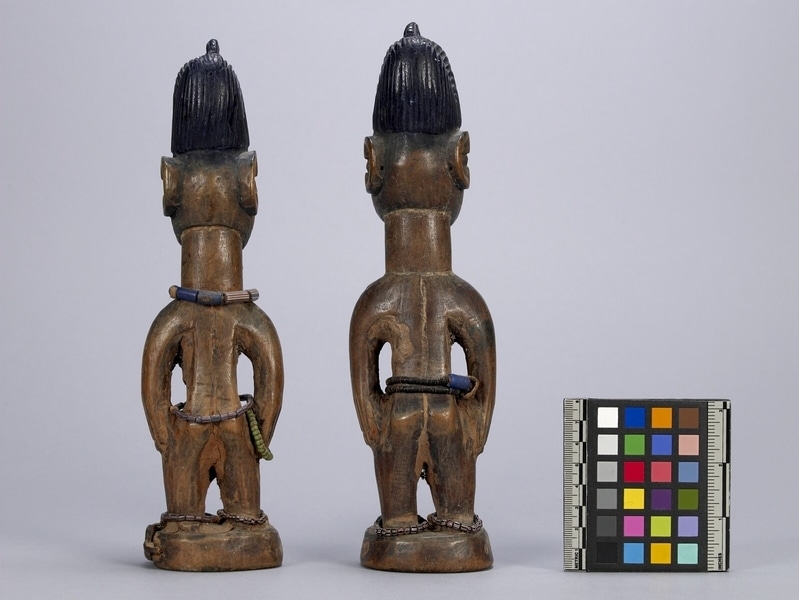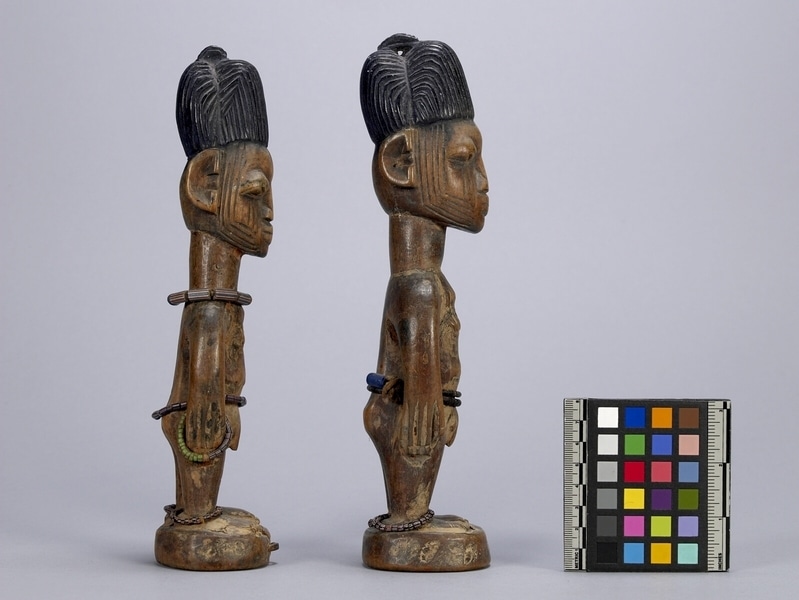Figure Item Number: K2.220 a-b from the MOA: University of British Columbia




Description
Standing wood figures (ibeji). Two male figures, with the one (part a) slightly smaller than the second (part b). Both have black hair indicated by incised line patterns. Each figure has incised tribal marks, four of which are vertical at the top middle of the forehead with another three vertical on the cheeks. Part a has four more, while part b has five more tribal marks vertical along the sides of the face extending at a diagonal angle downward along the middle bottom of the face. More tribal marks radiate from and point downward from the naval. There are also vertical tribal marks on the chest. Extended arms have hands touching thighs. The legs of each figure are very short in relation to body and the feet are fairly large. The first figure (part a) has a necklace of long red, white, and blue cylindrical beads with smaller beads of a similar kind around its waist, right wrist, and both ankles. The second figure (part b) has two strings of tiny brown beads around its waist with anklets of a similar kind to the first figure (part a). Each stands on circular pedestal.
History Of Use
Based on the sacred duality of "twoness" (èjìwàpò) found in nature, such as life/death, right/left, male/female, twins are understood as bringers of wealth and blessings to their family if they are satisfied, or misfortune if they are dissatisfied. As a result, living twins are treated with a high degree of respect and favouritism. When a twin, or both, dies the parents consult a diviner (babalawo), who communicates the desires of the deceased; small commemorative wooden figures (ère ìbejì) are carved to honour and represent them. Yorubas believe that twins share a soul, so the family was to treat the figure as they would if the twin was still physically present. As a result, the twin was fed, washed and cared for. Rather than realistic representations, ère ìbejì are idealized forms. They are often decorated with cowrie shells, beaded or metal bracelets, necklaces, and anklets, and cosmetics, such as osun (camwood powder), indigo, and efun (white chalk). By the mid-19th century, Christianity and Islam began to influence the design of ère ìbejì. Yoruba Muslims sometimes commissioned ere ibeji with carved torah, or leather packets containing quotations from the Quran, while Yoruba Christians incorporated Virgin Mary medals or crucifixes. In the mid-20th century, manufactured or plastic dolls began to replace the traditional ère ìbejì. Today, these dolls, in addition to the use of photographs, continue to sustain the ère ìbejì tradition.
Narrative
Collected by Michael Mason for the Museum of Anthropology.
Iconographic Meaning
The facial scarification on both cheeks (ila, or “lineage face mark”) indicates a specific community to which the represented deceased twin belongs.
Item History
- Made in Nigeria
- Collected by Michael Mason during 1964
- Owned by Michael Mason before October 20, 1970
- Received from Michael Mason (Donor) on October 20, 1970
What
Who
- Culture
- Yoruba
- Field Collector
- Michael Mason
- Previous Owner
- Michael Mason
- Received from
- Michael Mason (Donor)
Where
- Holding Institution
- MOA: University of British Columbia
- Made in
- Nigeria
When
- Collection Date
- during 1964
- Ownership Date
- before October 20, 1970
- Acquisition Date
- on October 20, 1970
Other
- Item Classes
- carvings & sculpture
- Condition
- fair
- Current Location
- Case 100
- Accession Number
- 1803/0001 a-b